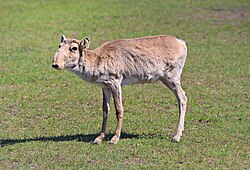Sometimes the most important news starts out as a couple of short paragraphs; for me, that’s how the Deepwater Horizon disaster began. I recall reading those two paragraphs, wherever it was, shaking my head and thinking, This is important.
And now I have the feeling again. NewScientist (30 May 2015, paywall) reports on the sudden deaths of saiga antelopes:
The animals began dying from an unidentified cause around 10 May. The death toll soared within days to 27,000, at which point the Kazakh government requested help from the secretariat of the convention. A team of vets, led by Richard Kock of the Royal Veterinary College in Hatfield, UK, flew out on Friday.
“It’s very dramatic and traumatic, with 100 per cent mortality,” Kock told New Scientist from Betpak-Dala in central Kazakhstan. “I know of no example in history with this level of mortality, killing all the animals and all the calves.” The animals die through severe diarrhoea and difficulty breathing.
100% mortality? That’s extremely worrying. Saiga antelope are a critically endangered species,
… that originally inhabited a vast area of the Eurasian steppe zone from the foothills of the Carpathian Mountains and Caucasus into Dzungaria and Mongolia.
They also lived in Beringian North America during the Pleistocene. Today, the dominant subspecies (S. t. tatarica) is only found in one location in Russia (steppes of the northwest Precaspian region) and three areas in Kazakhstan (the Ural, Ustiurt and Betpak-Dala populations).
They also having this charming appearance:
Scientists had come to watch the calving scene, but, according to WBUR, NPR’s Boston, MA station,
… but instead, what they witnessed was the end of life—with the carcasses of tens of thousands strewn over the terrain. Steffen Zuther, acting director of the Association for the Conservation of Biodiversity of Kazakhstan, was among the first witnesses on the scene. On May 10 and 11 and in the days that followed, he observed the devastation: whole herds lying dead—the carcasses of calves curled up at the bellies of their dead mothers.
Nature has a briefing on the event, including some interesting background:
Saigas are known to be prone to massive, as yet unexplained die-offs. These usually occur when the females come together to calve in the spring. In 1984, such an event in the Ural Mountains resulted in the loss of 100,000 animals — 67% of the local population. There were several smaller scale die-offs in the 2000s. But this year’s mass-death event among animals living in the Betpak-Dala region of Kazakhstan is much more significant as entire herds are dying.
“I have worked in veterinary diseases all my career and I have never seen 100% mortality,” says Richard Kock, a wildlife veterinarian at the Royal Veterinary College in Hatfield, UK, who flew out to Kazakhstan last month to assist with efforts to make sense of the devastation. “We had a herd of 60,000 aggregated and they all died. That is extraordinary.” …
The cause is unlikely to have been an infectious agent that was transmitted from one animal to the next. “Epidemiologically, you cannot get a directly transmitted disease to kill a whole population in seven days,” says Kock. “I’d say it’s a polymicrobial disease,” he says. This involves pathogens such as pasteurella and clostridia that are often present in the body but have seized an opportunity to run riot.
The pathogens may have been responsible for the deaths, but something must have caused the saigas to fall victim to them. Given that two discrete sub-populations some 300 kilometres apart suffered similarly and simultaneously, it seems likely that an environmental factor is part of the story.
The speculation, so far, appears to be purely concerning biological factors.





